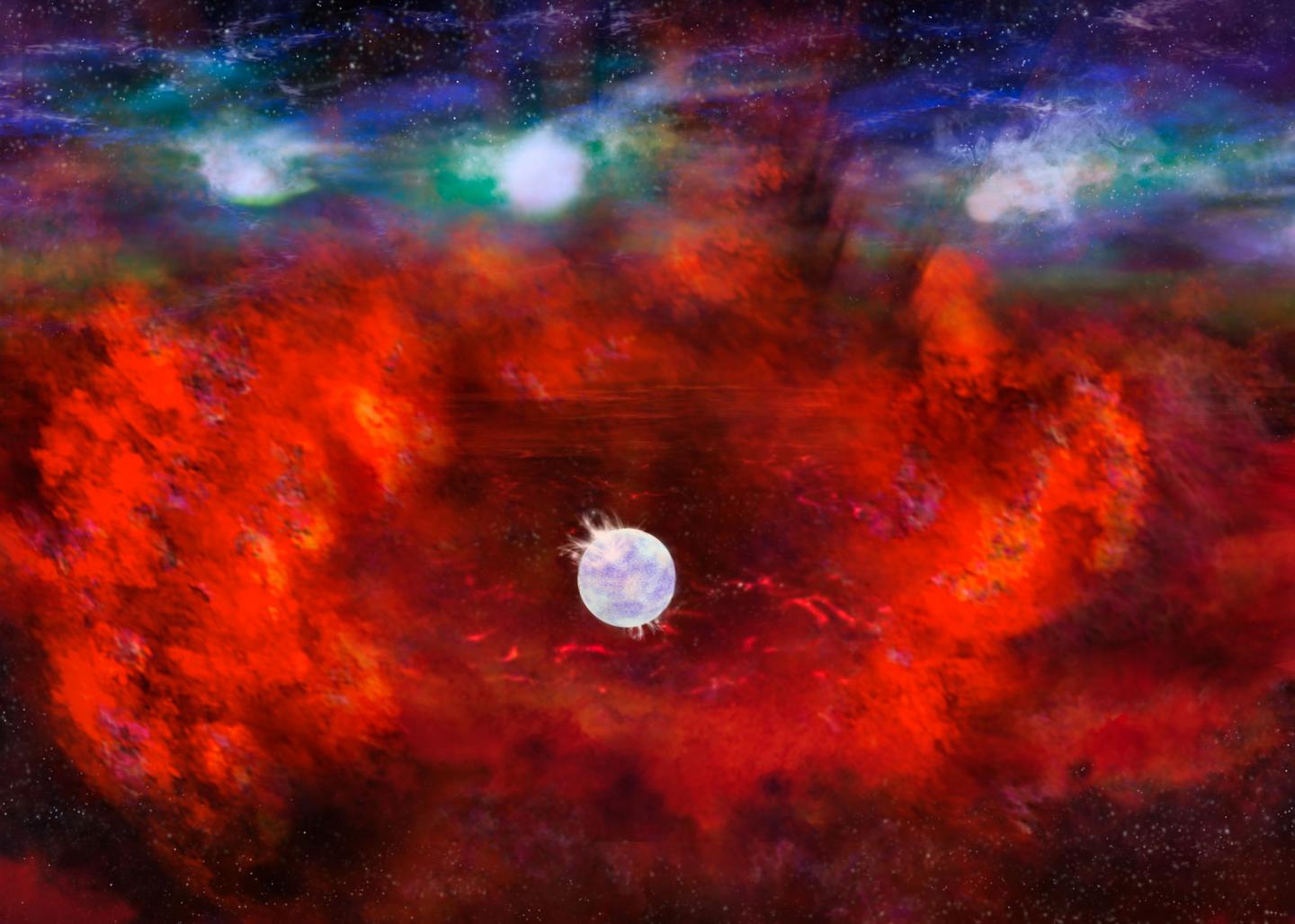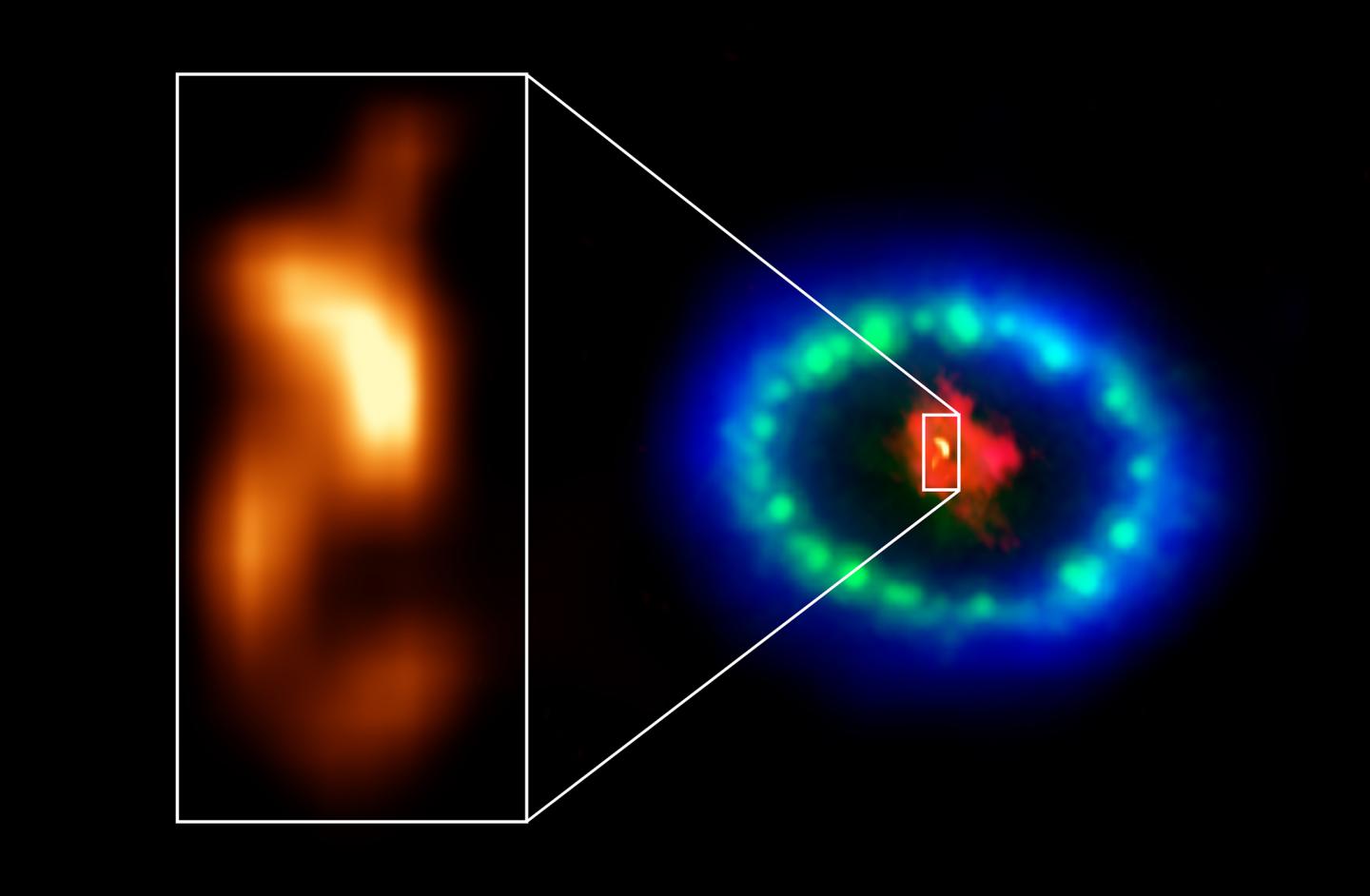Signs of 'missing' neutron star found in heart of supernova
It could be the youngest neutron star ever seen.

Evidence of a neutron star hidden deep inside Supernova 1987A is helping astronomers solve a 33-year-old mystery surrounding one of the brightest star explosions ever observed.
On Feb. 23, 1987, astronomers witnessed an incredibly bright stellar explosion, also known as a supernova. Using the Atacama Large Millimeter/submillimeter Array (ALMA), researchers believe they have found that explosion's remnants, a superdense corpse called a neutron star, hiding within the dust of the supernova.
High-resolution ALMA images revealed what researchers described as a hot "blob" that is brighter than its surroundings and located at the supernova's dusty core. If confirmed, this neutron star would be the youngest known to date, according to a statement.
Related: New views of famed supernova reveal cosmic dust factory
"We were very surprised to see this warm blob made by a thick cloud of dust in the supernova remnant," Mikako Matsuura, an astronomer at Cardiff University and one of the researchers who spotted the blob, said in the statement. "There has to be something in the cloud that has heated up the dust and which makes it shine. That's why we suggested that there is a neutron star hiding inside the dust cloud."
Their findings were published in November 2019, in The Astrophysical Journal. At the time, however, the researchers could not definitively say what the glowing blob was, as it was believed to be too bright to be a neutron star.
A new paper offers an explanation for that brightness in a neutron star: the glowing blob is consistent with thermal emission from a very young neutron star that is still really hot from the supernova explosion, according to the statement.
Get the Space.com Newsletter
Breaking space news, the latest updates on rocket launches, skywatching events and more!
"In spite of the supreme complexity of a supernova explosion and the extreme conditions reigning in the interior of a neutron star, the detection of a warm blob of dust is a confirmation of several predictions," Dany Page, an astronomer at the National Autonomous University of Mexico, said in the statement. Page led the new study, which was published on July 30 in The Astrophysical Journal.

The researchers estimate the temperature of the 15.5 mile (25 kilometer) wide neutron star is approximately 9 million degrees Fahrenheit (5 million degrees Celsius), which provides enough energy to explain the blob's brightness. The study also suggests the neutron star is located off-center, as researchers expect, due to the powerful stellar blast.
Before now, the neutron star remained elusive, shrouded by the supernova's thick cloud of dust, prompting scientists to wonder whether a black hole formed in the wake of the explosion instead. However, on the day of the explosion in 1987, subatomic particles known as neutrinos, which have almost no mass, were detected on Earth, suggesting a neutron star formed following the collapse of the star.
"The neutron star behaves exactly like we expected," James Lattimer, a member of Page's research team from Stony Brook University in New York, said in the statement. "Those neutrinos suggested that a black hole never formed, and moreover it seems difficult for a black hole to explain the observed brightness of the blob. We compared all possibilities and concluded that a hot neutron star is the most likely explanation."
At only 33 years old, this neutron star would be the youngest ever found. The next youngest is 330 years old, a neutron star located in the supernova remnant Cassiopeia A. Researchers hope to directly image this infant neutron star as the dust and gas in the supernova remnant fades over the next few decades, offering definitive proof that the star exists.
Follow Samantha Mathewson @Sam_Ashley13. Follow us on Twitter @Spacedotcom and on Facebook.
Join our Space Forums to keep talking space on the latest missions, night sky and more! And if you have a news tip, correction or comment, let us know at: community@space.com.

Samantha Mathewson joined Space.com as an intern in the summer of 2016. She received a B.A. in Journalism and Environmental Science at the University of New Haven, in Connecticut. Previously, her work has been published in Nature World News. When not writing or reading about science, Samantha enjoys traveling to new places and taking photos! You can follow her on Twitter @Sam_Ashley13.
-
dfjchem721 Technically SN 1987A* is much older than Cassiopeia A**, which is only about 11,330 years old.Reply
At its distance of about 168,000 light years in the LMC, SN 1987A is more like ca. 168,033 years old, just for the sake of accuracy.
And one might reasonably assume that it would be pretty hot for some time following core collapse. That was not a firecracker going off!
SN 1987A rewrote the book on type II supernovas, which previously were thought to occur only with red giants. The progenitor star for this SN was a blue giant. An excerpt from the below link*:
"Four days after the event was recorded, the progenitor star was tentatively identified as Sanduleak −69 202 (Sk -69 202), a blue supergiant. After the supernova faded, that identification was definitively confirmed by Sk −69 202 having disappeared. This was an unexpected identification, because models of high mass stellar evolution at the time did not predict that blue supergiants are susceptible to a supernova event."
end quote
Noting that : "models of high mass stellar evolution at the time did not predict that blue supergiants are susceptible to a supernova event" makes one wonder what else they are so very wrong about. Of course they didn't even know they were wrong until nature demonstrated it in no uncertain terms with this SN.
It seems likely that nature will be correcting other "models" before long!!!!!!! ( Time will tell, as it usually does.)
* https://en.wikipedia.org/wiki/SN_1987A
To see an image of SN 1987A, check out this poster's avatar!
** https://en.wikipedia.org/wiki/Cassiopeia_A -
rod Calling the area blob sounds similar to the 1958 movie with Steve McQueen, 'The Blob' 🙂 You can watch short trailers using BING or Google searches. The angular resolution reported for this blob by ALMA is 80 mas. At 51.4E+3 pc distance, the size of this blob is at least 4112 AU across 🙂 The ALMA blob in SN1987A is even bigger than the blob in the 1958 movie 🙂Reply









